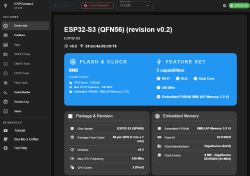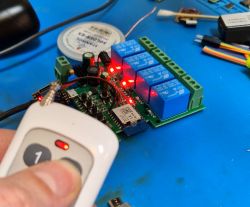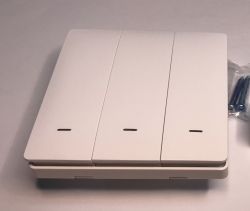Hi all,
This is my first time trying anything like this so apologies for any stupidity in advance. I've had a couple of the bulbs pictured for a while using Tuya Local in Home Assistant but got fed up with them disconnecting so decided to have a try using tuya-cloudcutter and flashing with Openbeken.
I successfully flashed with BK7231N and determined that it is a BP5758 using P6 as DAT and P9 as CLK.
This work but I didn't really consider the fact this bulb is RGBW rather than RGBCW. I've used the Flag 24 ("Flag 24 - [LED] Emulate Cool White with RGB in device with four PWMS") which works, but the colour temperature is way off, with far too much cold white being used. This is also additionally problematic because when the device appears in Home Assistant the lowest Kelvin that's available in the controls is 2702K, compared with 2000K when using OpenBeken directly.
Are there are settings that I can use to help resolve these issues?
![[BK7231N] TIMEGUARD WLFLB22 - 10W RGB/W/WW - Colour Temperature Issues [BK7231N] TIMEGUARD WLFLB22 - 10W RGB/W/WW - Colour Temperature Issues](https://obrazki.elektroda.pl/9237688600_1684312321_thumb.jpg)
![[BK7231N] TIMEGUARD WLFLB22 - 10W RGB/W/WW - Colour Temperature Issues [BK7231N] TIMEGUARD WLFLB22 - 10W RGB/W/WW - Colour Temperature Issues](https://obrazki.elektroda.pl/5155931700_1684312317_thumb.jpg)
![[BK7231N] TIMEGUARD WLFLB22 - 10W RGB/W/WW - Colour Temperature Issues [BK7231N] TIMEGUARD WLFLB22 - 10W RGB/W/WW - Colour Temperature Issues](https://obrazki.elektroda.pl/6286555100_1684312320_thumb.jpg)
![[BK7231N] TIMEGUARD WLFLB22 - 10W RGB/W/WW - Colour Temperature Issues [BK7231N] TIMEGUARD WLFLB22 - 10W RGB/W/WW - Colour Temperature Issues](https://obrazki.elektroda.pl/7381558300_1684312327_thumb.jpg)
![[BK7231N] TIMEGUARD WLFLB22 - 10W RGB/W/WW - Colour Temperature Issues [BK7231N] TIMEGUARD WLFLB22 - 10W RGB/W/WW - Colour Temperature Issues](https://obrazki.elektroda.pl/6539904500_1684312332_thumb.jpg)
![[BK7231N] TIMEGUARD WLFLB22 - 10W RGB/W/WW - Colour Temperature Issues [BK7231N] TIMEGUARD WLFLB22 - 10W RGB/W/WW - Colour Temperature Issues](https://obrazki.elektroda.pl/2702410000_1684312338_thumb.jpg)
![[BK7231N] TIMEGUARD WLFLB22 - 10W RGB/W/WW - Colour Temperature Issues [BK7231N] TIMEGUARD WLFLB22 - 10W RGB/W/WW - Colour Temperature Issues](https://obrazki.elektroda.pl/3790655600_1684312346_thumb.jpg)
This is my first time trying anything like this so apologies for any stupidity in advance. I've had a couple of the bulbs pictured for a while using Tuya Local in Home Assistant but got fed up with them disconnecting so decided to have a try using tuya-cloudcutter and flashing with Openbeken.
I successfully flashed with BK7231N and determined that it is a BP5758 using P6 as DAT and P9 as CLK.
This work but I didn't really consider the fact this bulb is RGBW rather than RGBCW. I've used the Flag 24 ("Flag 24 - [LED] Emulate Cool White with RGB in device with four PWMS") which works, but the colour temperature is way off, with far too much cold white being used. This is also additionally problematic because when the device appears in Home Assistant the lowest Kelvin that's available in the controls is 2702K, compared with 2000K when using OpenBeken directly.
Are there are settings that I can use to help resolve these issues?
![[BK7231N] TIMEGUARD WLFLB22 - 10W RGB/W/WW - Colour Temperature Issues [BK7231N] TIMEGUARD WLFLB22 - 10W RGB/W/WW - Colour Temperature Issues](https://obrazki.elektroda.pl/9237688600_1684312321_thumb.jpg)
![[BK7231N] TIMEGUARD WLFLB22 - 10W RGB/W/WW - Colour Temperature Issues [BK7231N] TIMEGUARD WLFLB22 - 10W RGB/W/WW - Colour Temperature Issues](https://obrazki.elektroda.pl/5155931700_1684312317_thumb.jpg)
![[BK7231N] TIMEGUARD WLFLB22 - 10W RGB/W/WW - Colour Temperature Issues [BK7231N] TIMEGUARD WLFLB22 - 10W RGB/W/WW - Colour Temperature Issues](https://obrazki.elektroda.pl/6286555100_1684312320_thumb.jpg)
![[BK7231N] TIMEGUARD WLFLB22 - 10W RGB/W/WW - Colour Temperature Issues [BK7231N] TIMEGUARD WLFLB22 - 10W RGB/W/WW - Colour Temperature Issues](https://obrazki.elektroda.pl/7381558300_1684312327_thumb.jpg)
![[BK7231N] TIMEGUARD WLFLB22 - 10W RGB/W/WW - Colour Temperature Issues [BK7231N] TIMEGUARD WLFLB22 - 10W RGB/W/WW - Colour Temperature Issues](https://obrazki.elektroda.pl/6539904500_1684312332_thumb.jpg)
![[BK7231N] TIMEGUARD WLFLB22 - 10W RGB/W/WW - Colour Temperature Issues [BK7231N] TIMEGUARD WLFLB22 - 10W RGB/W/WW - Colour Temperature Issues](https://obrazki.elektroda.pl/2702410000_1684312338_thumb.jpg)
![[BK7231N] TIMEGUARD WLFLB22 - 10W RGB/W/WW - Colour Temperature Issues [BK7231N] TIMEGUARD WLFLB22 - 10W RGB/W/WW - Colour Temperature Issues](https://obrazki.elektroda.pl/3790655600_1684312346_thumb.jpg)







![[BK7231N] TIMEGUARD WLFLB22 - 10W RGB/W/WW - Colour Temperature Issues [BK7231N] TIMEGUARD WLFLB22 - 10W RGB/W/WW - Colour Temperature Issues](https://obrazki.elektroda.pl/3024391500_1684484179_thumb.jpg)
![[BK7231N] TIMEGUARD WLFLB22 - 10W RGB/W/WW - Colour Temperature Issues [BK7231N] TIMEGUARD WLFLB22 - 10W RGB/W/WW - Colour Temperature Issues](https://obrazki.elektroda.pl/5408160300_1684484264_thumb.jpg)